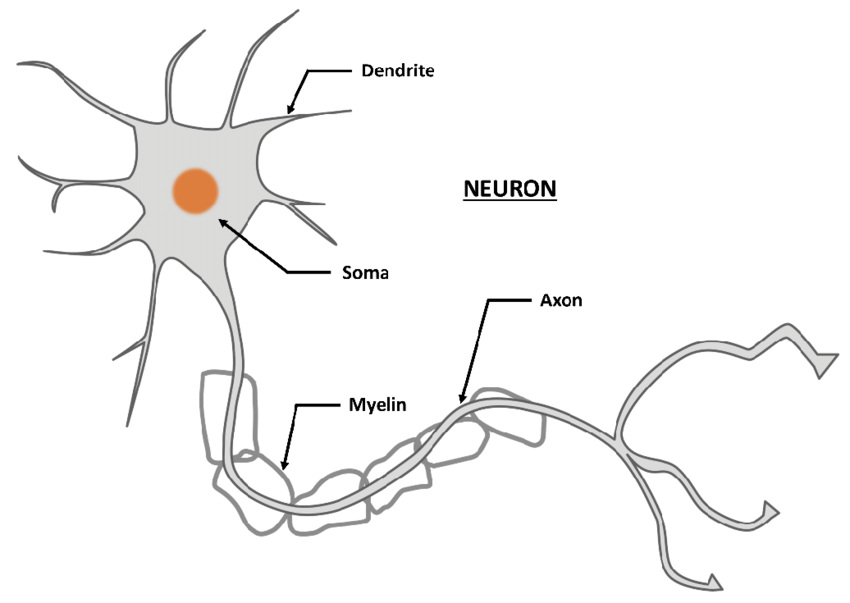Necessary basics for how the brain works
The brain is one of the most complex and fascinating organs in the human body. It controls everything we do, think, and feel by using specialized cells and intricate networks. This page provides a basic introduction to the brain’s fundamental components and their functions.
Note: Yes, the brain is a lot more complicated than the information provided on this page. We’ll probably discuss more details as they come up in class, but this should be helpful!
1. Neurons: The Brain’s Building Blocks
Neurons are the primary cells of the nervous system, responsible for transmitting information. A typical neuron has three main parts:
- Dendrites: Receive signals from other neurons.
- Cell Body (Soma): Processes the incoming signals.
- Axon: Sends signals to other neurons.
 *Credit: Luca Giannoni*
*Credit: Luca Giannoni*
2. Synapses and Synaptic Transmission
Neurons communicate at junctions called synapses. When a neuron sends a signal to another neuron, it occurs in the following steps:
- Electrical Signal: An electrical impulse travels down the axon to the synaptic terminal.
- Neurotransmitter Release: At the synapse, the signal triggers the release of chemical messengers called neurotransmitters.
- Receptor Activation: These neurotransmitters bind to receptors on the neighboring neuron, initiating a response.
Below is a video explanation of how synapses communicate:
3. Neurotransmitters: Chemical Messengers
Dopamine
- Function: Involved in reward, motivation, and motor control.
- Role: Dopamine helps regulate mood and behavior, playing a significant role in the brain’s reward system. It is linked to Parkinson’s.
Adrenaline (Epinephrine)
- Function: A key player in the fight-or-flight response.
- Role: Prepares the body for rapid action by increasing heart rate and energy.
Serotonin
- Function: Regulates mood, sleep, appetite, and memory.
- Role: Low levels of serotonin are associated with depression and anxiety.
If you want more detail on neurotransmitters, see the video linked below
4. Brain Networks: Communication Hubs
The brain is not just a collection of isolated regions working independently; instead, it operates as a highly interconnected system of networks. These networks are groups of brain regions that work together to process specific types of information or perform particular tasks. The existence of networks in the brain is a fundamental organizational principle, arising from both evolutionary and functional needs.
Why Do Networks Exist?
Efficiency and Specialization
- The brain has evolved to handle vast amounts of information efficiently. Networks allow for the division of labor, where different regions specialize in processing specific kinds of information, like vision, movement, or decision-making. Specialization reduces redundancy and increases the speed and accuracy of information processing.
Integration and Communication
- While individual regions specialize, networks ensure these regions can communicate seamlessly. For example, recognizing a face involves the visual network (for shape and color recognition) and the limbic network (for associating the face with emotions or memories). Networks integrate diverse streams of information to produce coherent thoughts, behaviors, and responses.
Adaptability and Plasticity
- Networks provide flexibility. Depending on the task, networks can dynamically reconfigure themselves. For instance, during learning, the brain’s networks adjust connections to strengthen relevant pathways and weaken unused ones. This plasticity allows humans to adapt to new environments, learn new skills, and recover from injuries.
The brain functions as a vast network of interconnected regions that process different types of information. These networks include:
- Default Mode Network (DMN): Active during rest, self-referential thoughts, and the forming of memories.
- Ventral Attention (Salience) Network: Detects and filters important sensory information.
- Executive Control Network: Governs decision-making and problem-solving.
- Motor and Sensory Networks: Coordinate movement and sensory input.
Brain networks rely on the seamless integration of electrical and chemical signaling to enable complex behaviors and thoughts.
REFERENCE:
Purves D, Augustine GJ, Fitzpatrick D, Hall WC, Lamantia AS, McNamara JO, White LE. Neuroscience. 4th ed. Sunderland, MA. Sinauer Associates; 2008.